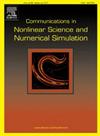具有生命动力学、再感染和随机性的 SIR 模型,用于研究传染病的传播
IF 3.4
2区 数学
Q1 MATHEMATICS, APPLIED
Communications in Nonlinear Science and Numerical Simulation
Pub Date : 2024-09-21
DOI:10.1016/j.cnsns.2024.108359
引用次数: 0
摘要
我们研究了具有生命动力学、再感染以及传播系数和招募率随机性的 SIR 模型。首先,我们对自主情景进行了广泛的分析,包括局部和全局的良好假设、吸引子的存在和内部结构以及梯度动力学的存在等方面。随后,我们探讨了小的非自主随机扰动的影响,确定了吸引子的连续性,并确保其拓扑结构的稳定性。此外,我们还研究了传输系数和招募率都表现出时间依赖性或随机行为的情况。对于每种情况,我们都确定了吸引子的存在,并划定了决定疾病是否根除或达到流行状态的条件。最后,我们通过数值模拟来说明理论结果。本文章由计算机程序翻译,如有差异,请以英文原文为准。
SIR models with vital dynamics, reinfection, and randomness to investigate the spread of infectious diseases
We investigate SIR models with vital dynamics, reinfection, and randomness at the transmission coefficient and recruitment rate. Initially, we conduct an extensive analysis of the autonomous scenario, covering aspects such as local and global well-posedness, the existence and internal structure of attractors, and the presence of gradient dynamics. Subsequently, we explore the implications of small nonautonomous random perturbations, establishing the continuity of attractors and ensuring their topological structural stability. Additionally, we study scenarios in which both the transmission coefficient and the recruitment rate exhibit time-dependent or random behavior. For each scenario, we establish the existence of attractors and delineate conditions that determine whether the disease is eradicated or reaches an endemic state. Finally, we depict numerical simulations to illustrate the theoretical results.
求助全文
通过发布文献求助,成功后即可免费获取论文全文。
去求助
来源期刊

Communications in Nonlinear Science and Numerical Simulation
MATHEMATICS, APPLIED-MATHEMATICS, INTERDISCIPLINARY APPLICATIONS
CiteScore
6.80
自引率
7.70%
发文量
378
审稿时长
78 days
期刊介绍:
The journal publishes original research findings on experimental observation, mathematical modeling, theoretical analysis and numerical simulation, for more accurate description, better prediction or novel application, of nonlinear phenomena in science and engineering. It offers a venue for researchers to make rapid exchange of ideas and techniques in nonlinear science and complexity.
The submission of manuscripts with cross-disciplinary approaches in nonlinear science and complexity is particularly encouraged.
Topics of interest:
Nonlinear differential or delay equations, Lie group analysis and asymptotic methods, Discontinuous systems, Fractals, Fractional calculus and dynamics, Nonlinear effects in quantum mechanics, Nonlinear stochastic processes, Experimental nonlinear science, Time-series and signal analysis, Computational methods and simulations in nonlinear science and engineering, Control of dynamical systems, Synchronization, Lyapunov analysis, High-dimensional chaos and turbulence, Chaos in Hamiltonian systems, Integrable systems and solitons, Collective behavior in many-body systems, Biological physics and networks, Nonlinear mechanical systems, Complex systems and complexity.
No length limitation for contributions is set, but only concisely written manuscripts are published. Brief papers are published on the basis of Rapid Communications. Discussions of previously published papers are welcome.
 求助内容:
求助内容: 应助结果提醒方式:
应助结果提醒方式:


